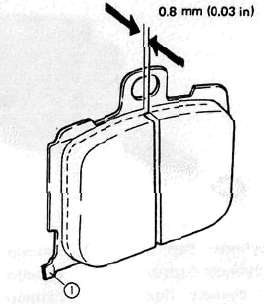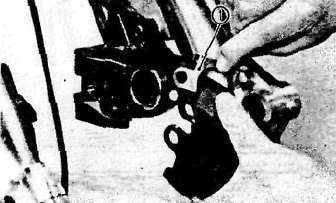1. Remove the caliper brake hose. Allow fluid in the caliper assembly to drain into a container.
2. Place the open hose end into the container and pump the old fluid out carefully.
3. Remove the caliper mounting bolt and the pad retaining bolt.
4. Remove the caliper assembly from the caliper frame.
5. Remove the dust seal.
6. Remove the piston.
CAUTION:
Cover the piston with a rag. Use care so that the piston does not cause injury as it is expelled from the cylinder.
7. Remove the piston seal.
C. Master Cylinder Disassembly
1. Remove the brake light switch.

2. Remove the brake hose.

3. Remove the brake lever and spring.
4. Remove the master cylinder from the handlebar. Remove the cap and drain the remaining fluid.
5. Remove the master cylinder dust boot.
6. Remove the snap ring.

7. Remove the master cylinder cup assembly. Note that the cylinder cups are installed with the larger diameter (lips) inserted first.
D. Brake Inspection and Repair
Recommended Brake Component
Replacement Schedule: Brake pads; As required Piston seal, dust seal; Every two years Brake hoses; Every four years Brake fluid; Replace only when brakes are disassembled
1. Replace the caliper piston if it is scratched.

2. Replace any brake pad worn beyond limits. Always replace the brake pads as a set.
Wear limit: 0.8 mm (0.03 in)

1. Wear indicator
3. Replace piston and dust seals if damaged. Replace seals every two years.
4. Inspect master cylinder body. Replace if scratched. Clean all passages with new brake fluid.
5. Inspect the brake hoses. Replace every four years or immediately if cracked, frayed, or damaged.
6. Check for wear and deflection of disc.
Maximum deflection: 0.15 mm (0.006 in)
Minimum disc thickness: 4.5 mm (0.18 in)

1. Dial gauge
2. Disc
3. Dial gauge
If disc is worn beyond minimum thickness or deflection exceeds specified amount, replace disc.
E. Brake Reassembly
1. All internal parts should be cleaned in new brake fluid only. Internal parts should be lubricated with brake fluid when installed.
2. Caliper Reassembly
Replace the following parts whenever a caliper is disassembled: bleed screw and cap, boot bushing, piston seal, and dust seal.
a. Install the piston seal and piston. Place the caliper cylinder into the caliper frame.
b. Install the caliper assembly on the front fork.
Tightening torque: 35 Nm (3.5 mkg, 25 ft-lb)
c. Install the new brake pads and shims. Before installing the pads, install the shim on the back plate which faces the caliper piston, as shown.

1. Shim
Retaining bolt tightening torque: 22.5 Nm (2.25 m-kg, 16 ft-lb)
3. Attach the brake hoses (front and rear).
Brake hose torque: 25 Nm (2.5 m-kg, 18fMb)
4. Brake disc assembly
If brake disc has been removed from hub or is loose, tighten bolts. Use new locking washers and bend over locking tabs after bolts are tightened.
Disc bolt torque:
20 Nm (2.0m-kg, 14.5 ft-lb)
5. Master cylinder reassembly

1. Union bolt
2. Copper washer
3. Matter cylinder kit
Reassemble master cylinder as shown in illustration.
Brake hose torque: (all brake union bolts) 25 Nm (2.5 m-kg, 18.0ft.lb)
6. Air bleeding
Warning:
If the brake system is disassembled or if any brake hose has been loosened or removed, the brake system must be bled to remove air from the brake fluid. If the brake fluid level is very low or brake operation is incorrect, bleed the brake system.
Failure to bleed the brake system properly can result in a dangerous loss of braking performance.
a. Add proper brake fluid to the reservoir. Install the diaphragm, being careful not to spill or overflow the reservoir.
b. Connect the clear plastic tube of 4.5 mm (3/16 in) inside diameter tightly to the
caliper bleed screw. Put the other end of the tube into a container.

c. Slowly apply the brake lever several times. Pull in the lever. Hold the lever in "on" position. Loosen the bfeed screw. Allow the lever to travel slowly toward its limit. When the limit is reached, tighten bleed screw. Then release the lever.
d. Repeat step "c" procedure until all air bubbles are removed from system.
NOTE:
If bleeding is difficult, it may be necessary to let the brake fluid system stabilize for a few hours. Repeat the bleeding procedure when the tiny bubbles in the system settle out.
- Printer-friendly version
- Log in to post comments
